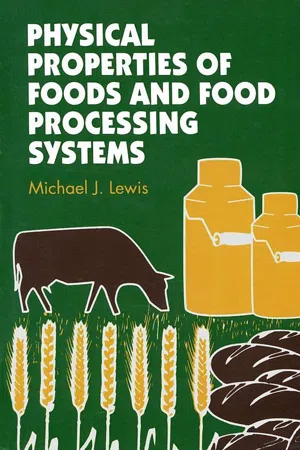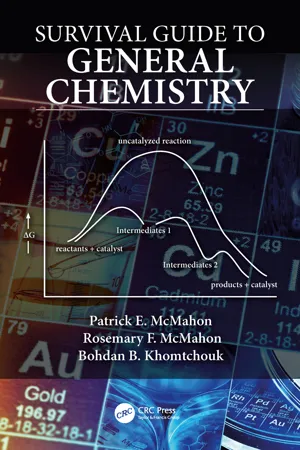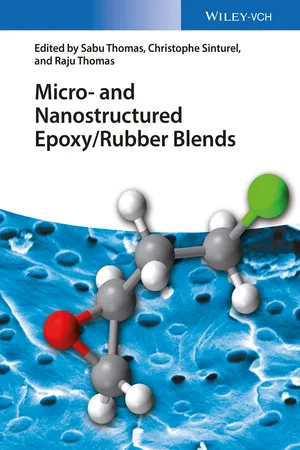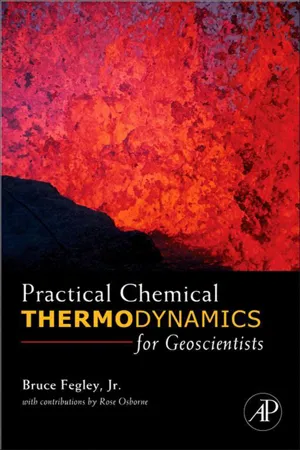Chemistry
Specific Heat
Specific heat is the amount of heat energy required to raise the temperature of a substance by a certain amount. It is a physical property that varies for different materials and is measured in joules per gram degree Celsius (J/g°C) or calories per gram degree Celsius (cal/g°C). Specific heat is important in understanding how substances respond to changes in temperature.
Written by Perlego with AI-assistance
Related key terms
Related key terms
1 of 4
Related key terms
1 of 3
11 Key excerpts on "Specific Heat"
- Christopher R. Hren, John T. Moore, Peter J. Mikulecky(Authors)
- 2022(Publication Date)
- For Dummies(Publisher)
Specific Heat ). Molar heat capacity is simply the heat capacity of 1 mole of a substance. Specific Heat capacity is simply the heat capacity of 1 gram of a substance. How do you know whether you’re dealing with heat capacity, molar heat capacity, or Specific Heat capacity? Look at the units.- Heat capacity:
- Molar heat capacity:
- Specific Heat capacity:
Specific Heat capacity is the one that you will likely be dealing with the most in your chemistry class, so pay careful attention to it. For any given substance there is a number that represents the amount of energy, usually measured in joules, required to raise 1 g of that substance by 1°C, or 1 K. If you have a larger amount of a substance, raising the temperature will take longer. It is something you likely have some understanding of based on your everyday experience. To give you a practical and familiar example, imagine two pots of water, one big and one small, coming to a boil on a stove. The flame underneath each pot is the same, meaning the amount of energy being added to both is the same. Which one will boil faster? You probably already know the small one will boil faster and the big one will take longer. Why? Since there is more mass it takes longer for the water to heat to heat up.The other major concept of Specific Heat is that different substances, of the same mass, will heat up and cool off at different rates based on what they are composed of. Another example you might have familiarity with is the idea of going swimming on one of the first hot days of the year. Let’s say there is this lake you like to swim in. You know it is going to be the first really hot day of the year. You live where there is an actual winter, so it hasn’t been very warm for a while; say the temperature yesterday was 50°F — not very warm. Yet today, because this happens in some places, the temperature is a nice 83°F and sunny. The air will feel quite warm to you and likely the ground, depending on the material, will feel quite hot in some places. Yet it is likely that if you were to go jump into your favorite lake, you would probably not have a good time because it would likely still feel very, very cold. This is because water has a relatively high Specific Heat compared to other substances, meaning that it generally it takes more energy to heat water up, though it also works the other way as well. By the end of the summer, that lake will likely be feeling pretty warm, and it’ll stay warmer relative to the air temperature for quite some time because of water’s high Specific Heat. If it takes more energy and time to heat water up, it also will hold its heat for a correspondingly long time before cooling down.- eBook - ePub
- (Author)
- 2012(Publication Date)
- Dover Publications(Publisher)
We may speak of the capacity for heat of a particular thing, such as a copper vessel, in which case the capacity depends on the weight as well as on the kind of matter. The capacity of a particular thing is often expressed by stating the quantity of water which has the same capacity.We may also speak of the capacity for heat of a substance, such as copper, in which case we refer to unit of mass of the substance.DEFINITION OF Specific Heat.
The Specific Heat of a body is the ratio of the quantity of heat required to raise that body one degree to the quantity required to raise an equal weight of water one degree.The Specific Heat therefore is a ratio of two quantities of the same kind, and is expressed by the same number, whatever be the units employed by the observer, and whatever thermometric scale he adopts.It is very important to bear in mind that these phrases mean neither more nor less than what is stated in these definitions.Irvine, who contributed greatly to establish the fact that the quantity of heat which enters or leaves a body depends on its capacity for heat multiplied by the number of degrees through which its temperature rises or falls, went on to assume that the whole quantity of heat in a body is equal to its capacity multiplied by the total temperature of the body, reckoned from a point which he called the absolute zero. This is equivalent to the assumption that the capacity of the body remains the same from the given temperature downwards to this absolute zero. The truth of such an assumption could never be proved by experiment, and its falsehood is easily established by showing that the Specific Heat of most liquid and solid substances is different at different temperatures.The results which Irvine, and others long after him, deduced by calculations founded on this assumption are not only of no value, but are shown to be so by their inconsistency with each other.We shall now return to the consideration of the experiment with the lead and water, in order to show how it can be made more accurate by attending to all the circumstances of the case. I have purposely avoided doing so at first, as my object was to illustrate the meaning of ‘Specific Heat.’ - eBook - ePub
- R.A. Edwards(Author)
- 2014(Publication Date)
- Pergamon(Publisher)
CHAPTER 7The Measurement of Heat Quantity
Publisher Summary
This chapter describes different methods of measurement of heat quantity. The Specific Heat of a substance at any temperature is defined as the quantity of heat required to raise the temperature of unit mass of that substance by one degree. The thermal capacity of a body or mass of material is the quantity of heat required to raise the temperature of that body or mass of material by one degree. The quantity of heat required to convert unit mass of the solid into liquid without change of temperature is called its latent heat of fusion. The latent heat of vaporization, or evaporation, is the quantity of heat required to convert unit mass of liquid into vapor without change of temperature, that is, at the boiling point. The latent heat of fusion of ice can be measured by a simple method of mixtures. An electrical method could be used using a calorimeter similar to that used for the electrical method for the determination of the Specific Heats of solids. The calorific value of a fuel is the quantity of heat liberated as a result of the complete combustion of unit mass of the fuel. A gas calorimeter is used to measure the calorific value of gas fuels or of liquid fuels, which easily vaporize.7.1 Specific Heat
The Specific Heat of a substance at any temperature is defined as the quantity of heat required to raise the temperature of unit mass of that substance by one degree . For example, if an infinitesimal quantity of heat dH is required to raise a mass m of a substance from a temperature θ to a temperature θ + dθ , then the Specific Heat s of the substance is defined as(7.1)Modern practice is to express Specific Heat in joules per gram per degC (J g−1 degC−1 ) or alternatively in joules per kilogram per degC (J kg−1 degC−1 ). Over quite considerable ranges of temperature the value of s for a material often varies only slightly, but in accurate work its variation may be regarded as significant. If s may be considered constant over a finite change Δθ in temperature, then the heat ΔH gained or lost by a mass m of the substance in rising or falling through the temperature range Δθ - M J Lewis(Author)
- 1990(Publication Date)
- Woodhead Publishing(Publisher)
8Sensible and latent heat changes
8.1 INTRODUCTION
The properties to be discussed in this chapter include Specific Heat, latent heat and specific enthalpy.These properties play an important role in heat transfer problems when heating or cooling foods. It is necessary to know the Specific Heat to determine the quantity of energy that needs to be added or removed. This will give an indication of the energy costs involved and in a continuous process will have an influence on the size of the equipment.Latent heat values, which are associated with phase changes, play an important role in freezing, crystallization, evaporation and dehydration processes.8.2 Specific Heat
The Specific Heat of a material is a measure of the amount of energy required to raise unit mass by unit temperature rise. As mentioned in Chapter 7 , Specific Heat is temperature dependent. However, for the purpose of many engineering calculations, these variations are small and an average Specific Heat value is used for the temperature range considered.The units of Specific Heat are kilojoules per kilogram per kelvin (kJ kg−1 K−1 ), kilocalories per kilogram (kcal kg−1 K−1 ) or British thermal units per pound per degree Fahrenheit (Btu lb−1 degF−1 ). From the definitions of the different thermal units, the Specific Heat of water in the respective units is1 .0. kcal kg −1K −1or 4.18 kJ kg−1K −1or 1 Btu lb−1degF −1In a batch heating or cooling process, the amount of heat (energy) Q required or removed is given byIn a continuous process, the rate of heat transfer is given byQ = mass × average specific heat × temperature change= MC Δ TJ or kcal or BtuQ / t = mass flow rate × specific heat × temperature rangeThe units of Q /t are joules per second (J s−1 ), i.e. watts (W), or British thermal units per hour (Btu h−1 ). This is often termed the heating or cooling duty of the heat exchanger. If it is felt that this is not a sufficiently accurate procedure, the total energy requirement can be obtained by graphical integration. Specific Heat is plotted against temperature; the total heat required to raise unit mass from T 1 to T 2 is given by ∫cp dTor the area under the curve (Fig. 8.1 ) This should, in most cases, be not too far removed from the value obtained by selecting a Specific Heat value at the average temperature (T 1 + T 2 )/2. If the relationship between the Specific Heat and temperature is known in terms of temperature, then the integral ∫cpdT can be evaluated directly, (see section 8.4- eBook - ePub
Doing Physics with Scientific Notebook
A Problem Solving Approach
- Joseph Gallant(Author)
- 2012(Publication Date)
- Wiley(Publisher)
It takes 4186 J of heat to raise the temperature of 1 kg of water by 1 °C, but only 128 J does the same to lead. Something is different! Water and lead are different substances and they have different Specific Heats.The Specific Heat is the amount of heat needed to raise the temperature of 1 kg of a substance by 1 °C. It’s a measure of heat per unit mass per unit temperature. Its metric unit is J/kg/ °C, but kJ/kg/ °C and kcal/kg/ °C are also used. Specific Heat is a property of the substance, and it only depends on what the object is made of.The amount of heat needed to change an object’s temperature is(11.8)where m is the object’s mass, c is the Specific Heat of the substance the object is made of, and ΔT is the change in the object’s temperature.A positive Q indicates heat flows into the object; a negative Q means heat flows out of the object. Mass and Specific Heat are always positive, so the heat flow and temperature change always have the same sign. When heat flows in, ΔT and Q are both positive and the temperature increases. When heat flows out, ΔT and Q are both negative and the temperature decreases.How much heat must you add to 400 ml of 0 °C water to raise its temperature to 90 °C?Example 11.3Why do coffee cups have handles?Solution. Let’s use Evaluate Numerically and the definition of density to calculate the water’s mass.Use Evaluate and Eq. (11.8) to calculate the amount of heat. Notice the Specific Heat of water is 1 kcal/ (kg °C).Let’s repeat the calculation for aluminum, which has a significantly smaller Specific Heat.Water has a larger Specific Heat, so it needs more heat for the same temperature change. Water’s Specific Heat is larger than most common substances.Change in State: Latent Heat
Under ordinary circumstances, there are three states of matter - solid, liquid, gas - and heat must flow to transform matter from one state to another.The latent heat - eBook - ePub
Chemistry
With Inorganic Qualitative Analysis
- Therald Moeller(Author)
- 2012(Publication Date)
- Academic Press(Publisher)
law leads to one way to define temperature, albeit the definition is a negative one: If heat can flow from one body to another, they are at different temperatures; if no heat flows between two bodies, they are at the same temperature. Although we cannot measure the amount of heat within a single body, we can measure temperature changes and calculate the amount of heat involved in those changes. The subject of this chapter is thermochemistry—the study of the thermal energy associated with chemical and physical changes of substances .Heat
5.1 Heat and heat capacity
As an ice cube melts, heat is flowing to the cube from the air, or a surrounding liquid, or the table top. In every process, the heat gained in one place is lost in another. This is simply a consequence of the law of conservation of energy, which may be stated this way: The energy of the universe is constant . This is known as the first law of thermodynamics. Neither thermal energy nor any other kind of energy can disappear. Using q as a symbol for heat, the mathematical statement is this:(1)When heat is absorbed, or flows toward a body, q is given a positive sign—heat has been added to the body under consideration. When heat is released, or flows away from a body, q is given a negative sign—heat has been subtracted from the body under consideration.We observe heat flow by measuring changes in temperature. To calculate q we must know the change in temperature ΔT ; the mass or amount of the substance that has changed temperature; and a factor that expresses how much heat is required to raise by a certain amount the temperature of a given amount of the substance. The name for this factor is heat capacity , C —the amount of heat required to raise the temperature of a given amount of material by 1 Celsius degree. When this amount of the substance is expressed in moles, we refer to the molar heat capacity. Each substance has its own characteristic heat capacity; for example, it takes about 2 cal to raise the temperature of one mole of carbon in the form of coal by 1°C; for coal, C - eBook - ePub
- Charles Liu(Author)
- 2020(Publication Date)
- Visible Ink Press(Publisher)
Although the space between molecules typically increases between the solid, liquid, and gas phases, the space between molecules does not actually determine the state of matter of a substance. Rather, it is the amount of thermal energy in a substance. When that amount changes, the matter can change from one state to another if a phase boundary is crossed. The phase boundaries are determined by the temperature, pressure, and entropy of the matter. For example, the phase boundary between water and ice at the atmospheric pressure at sea level on Earth occurs at a temperature of 0 degrees C (32 degrees F). Water at that temperature, however, has more entropy than ice at that same temperature, so to melt ice into water, extra energy must be added, even though the temperature stays the same.Can matter change state from solid to gas without becoming liquid?
Yes, depending on the substance, the temperature, and the pressure. On Earth at sea level, for example, H2 O goes from solid (ice) to liquid (water) to gas (steam) as the temperature increases. Under those same conditions, however, CO2 (carbon dioxide) goes from solid (dry ice) to gas without becoming liquid first. This process is called sublimation.What determines the amount of energy required to increase the temperature of a substance?
Every substance has its own Specific Heat capacity, or the amount of heat needed to increase one kilogram of the substance one degree Celsius. For example, the Specific Heat capacity of water is 4,186 joules (4.186 kJ). The following table lists the Specific Heat capacities of some common solids, liquids, and gases.Substance Specific Heat Capacity (J/kg °C) Aluminum 897 Copper 387 Iron 445 Lead 129 Gold 129 Silver 235 Mercury 140 Wood 1,700 Glass 837 Water 4,186 Ice 2,090 Steam 2,010 Nitrogen 1,040 Oxygen 912 Carbon Dioxide 833 Ammonia 2,190 How is Specific Heat capacity used?
Specific Heat capacity is the energy per kilogram per change in temperature. So, to find the amount of energy needed to heat something, you need to know the material, its mass, and the change in temperature desired. For example, if you want to increase the temperature of 2 liters (2 kilograms) of water from room temperature (20°C) to the boiling point (100°C), you need to multiply the Specific Heat capacity of water (4,186 J/kg°C) by 2 kg and by 80°C to obtain 669,760 J, or about 670 kJ. - eBook - ePub
- Patrick E. McMahon, Rosemary McMahon, Bohdan Khomtchouk(Authors)
- 2019(Publication Date)
- CRC Press(Publisher)
(ΔT) = change in temperature in °C or K; (ΔT) is proportional to the amount of heat gained (+q) with (ΔT = +) or lost (−q) with (ΔT = −). In this specific case, either temperature scale is acceptable. The size of the degree unit for °C and K are the same; they differ only in their zero point. Since (ΔT) measures a difference (subtraction) of temperature measurements, the differing zero point of the temperature scales is not carried in the calculation.C (or Cp ) is the heat capacity (or Specific Heat capacity) of the matter involved in heat transfer. The Specific Heat capacity (C) is defined as the amount of heat (q) required to raise the mass of exactly 1 gram of a substance by exactly 1 Kelvin (K) or 1 degree centigrade (°C). The mass of the material or object must be measured in grams to match the units of heat capacity.The Specific Heat capacity measures the specific response of each compound or element to heat changes; units are Joules/gram-K or Joules/gram-°C. The degree Kelvin and the degree centigrade are the same size; for ΔT calculations, either temperature scale can be used. Each substance has a different response to temperature change as a function of heat changes. The higher the value of the heat capacity (C), the greater the amount of heat required to raise the temperature of a specific mass of matter by one degree. Values of Specific Heat capacity are found in tables.Example:C of Fe = 0.450 J/g-K C of glass = 0.84 J/g-K C of Al = 0.91 J/g-K C of wood = 1.76 J/g-K C of antifreeze = 2.42 J/g-KC of H2 O = 4.184 J/g-KSIMPLE HEAT TRANSFER FOR ONE SUBSTANCEThe general equation q = (ΔT)(m)(C) can be solved for the other unknown variables; the resulting equations can be used for both the system and surroundings.Δ T =(q) (c)(m)C =(q) (m)(T)mass (g) =(q) (C)(T)Example: Calculate the value of q (heat transfer) required to heat a 2.50-kilogram iron pot from 26°C to 100°C (299 K to 373 K); CFe = 0.450 J/g-K or J/g-°C.Step (1 - eBook - ePub
- Sabu Thomas, Christophe Sinturel, Raju Thomas(Authors)
- 2014(Publication Date)
- Wiley-VCH(Publisher)
14 Thermal PropertiesVincent Sobotka, Didier Delaunay, Nicolas Boyard, Sabu Thomas and Poornima Vijayan P.In the absence of flow, heat transfers within the epoxy resin are described by the classical equation of heat diffusion:14.1In the above equation the term corresponds to the heat source released by the cross-linking, with ΔH the cross-linking enthalpy and the cross-linking kinetics. This kinetics, whose models are presented in Chapter 6, depends on temperature. With both equations being then strongly coupled, the description of the transfers requires their simultaneous solving. It is then necessary to know the evolution of the density (ρ), as detailed in previous chapters, but also of the Specific Heat capacity (cp ) and of the thermal conductivity (λ). These parameters depend on temperature and on cross-linking. With the direct measurement of these properties during the transformation being intricate, they are most of the time measured outside the transformation area. Models are then used to describe their evolution as a function of the cross-linking degree.14.1 Specific Heat
Specific Heat capacity corresponds to the amount of heat required to raise the temperature of 1 g of a substance by 1 K. In the case of an isochoric evolution at variable pressure, the Specific Heat capacity cv = (∂u/∂T)v is used, u being the internal energy of the unit of mass. If the material encounters an isobaric evolution, the Specific Heat at constant pressure cp = (∂h/∂T)p , must be used, h being the enthalpy of the unit of mass. The equation of state of the material f(P,V,T) = 0 allows obtaining a relationship between cp and cv . Indeed the relation h = u + pv, with v being the specific volume, leads to cp − cv = d(pv)/dT. For solids and liquids, the variation of (pv) with the temperature is negligible, and cp and cv are generally considered equivalent. Indeed, the difference cp − cv - Bruce Fegley Jr.(Author)
- 2012(Publication Date)
- Academic Press(Publisher)
III , we discuss thermal properties of solids and liquids, including organics, water, molten metals, oxides, and silicates. We review common types of heat capacity anomalies exhibited by solids, discuss calculation of heat capacity and enthalpy for these anomalies, discuss calculation of heat capacity and enthalpy for phase transitions such as solid-state phase transitions, melting, and vaporization, and discuss methods for estimating heat capacity and enthalpy of solids when no experimental data are available.I Some Basic Concepts about Heat Capacity and Enthalpy
A Mean and true heat capacity
In Chapter 3 , we defined the heat capacity (C ) of a substance as the ratio of heat added to the substance divided by the resultant temperature change. Equation (3-39) is actually the definition of the mean heat capacity ( ):(3-39)The mean heat capacity approaches the true heat capacity (C ), given by Eq. (3-40) :(3-40)as the heat added q → 0 and the temperature interval ΔT → 0 (i.e., as both q and ΔT become infinitesimally small). The correction of the mean heat capacity, which is the quantity that is usually measured, to the true heat capacity (eitherCVorCP), which is the desired quantity, is done during the data analysis. The corrections are described in McCullough and Scott (1968).B Heat capacity contributions
The heat capacity of a material is generally due to the uptake of kinetic energy by its atoms and molecules. In most cases, the heat capacity (CP) of a material is the sum of two contributions. One contribution is the constant-volume heat capacityCV. The other contribution is that due to thermal expansion, which is simply (CP − CV- eBook - ePub
- Daniel H. Nichols(Author)
- 2018(Publication Date)
- CRC Press(Publisher)
Controlling the temperature of something like an oven requires knowing how much heat to add. Adding too much or too little heat will result in the oven being too hot or too cold. How much heat to add to reach a certain temperature will depend on how big the oven is and what it is made of. Not all materials change temperature by the same amount for the same heat input and weight. For example:■ Btu of heat added to 1 lb of steel raises the temperature by 8.7°F. ■ Btu of heat added to 1 lb of water raises the temperature by 1°F. ■ 4,184 J of heat added to 1 kg of water raises the temperature by 1°C.How much a material changes temperature for a given weight and heat input is determined by its Specific Heat capacity.10.9 Specific Heat CAPACITY
Specific Heat capacity is the amount of heat needed to raise the temperature of a given amount of a substance by 1°C. The Specific Heat capacity is given by the letter c .It takes 4,184 J of heat added to water to raise the temperature of 1 kg of water by 1°C.It takes 1 Btu of heat added to water to raise the temperature of 1 lb of water by 1°F.c= 4 , 184waterJkg ° Cc water= 1Btulb ° FMathematically, the change in temperature of a material of a given weight w or mass m , with Specific Heat capacity c, and heat exchanged Q is given by:ORΔ T =Qc ⋅ mTemperature change ( ° C) =heat (J)specific heat capacity(⋅ mass (kg)J)kg ° CTemperature change ( ° F) =heat (Btu)specific heat capacity(⋅ weight (lb)Btu)lb ° FWhich equation you choose depends on the units of the heat capacity. This equation says how much a material’s temperature changes depends on the amount of heat exchanged and is inversely proportional to its Specific Heat capacity and its weight or mass. If the Specific Heat and weight (or mass) are very large, a lot of heat is needed to change the temperature (Table 10.4 ).TABLE 10.4Heat CapacitiesExample 10.9
Index pages curate the most relevant extracts from our library of academic textbooks. They’ve been created using an in-house natural language model (NLM), each adding context and meaning to key research topics.
Explore more topic indexes
Explore more topic indexes
1 of 6
Explore more topic indexes
1 of 4










